Tags
Dodrul Chorten, Ganesh Tok, Gangtok, Kangchenjunga, Namygal Institute of Tibetology, North East India, Ridge Park, Rumtek Monastery, Sikkim, Tashi View Point, Tibetan food, Vishwakarma Pooja
Hi, A warm welcome to my blog 🙂
I hope that you all have enjoyed my two previous posts:
My Adventures in Darjeeling, Sikkim & Kalimpong – Part 1 of 7
My Adventures in Darjeeling, Sikkim & Kalimpong – Part 2 of 7
Here’s the continuing story… Happy reading 🙂
Tuesday, 16 September 2014
I wake up at 4:45 AM, in hopes of seeing the glorious golden sunrise over the Kanchenjunga. Looking out from my bedside window, I focus my eyes to the place where the holy peak is to be seen. Alas! For the second day in a row, Kanchenjunga is hidden by clouds. I’m distraught…this is my last chance to see it!
I spend the next fifteen minutes silently pleading with the Kanchenjunga. Helloooooo!!! Please say hello to me, pleeeease…hello, hi, hola… helllllllllloooo hiiiiiiiiiii holaaaaa Pleeease… Pleeaaseee… pleeease, please… I go on and on with my silent pleadings till my head starts feeling heavy and then…a thin white lining becomes visible just where Kanchenjunga is supposed to be seen and I start thinking…Is it really the Kanchenjunga? Perhaps it’s a silver lining to the clouds? I want to think that it’s the former but I see plenty of white shades in the dark blue sky. And still, my heart says it is the Kanchenjunga and my mind nods in agreement. Muaahks…thank you sooo much! I guess this is just as much that you can do seeing that the Sun is not co-operating.
This lovely photograph at 5:06 AM…
This lovely video at 5:09 AM: A bit of Kanchenjunga from my Pelling hotel room
From Pelling, Kanchenjunga is very close. So I expected a closer view but the great mountain looks so far off. In almost all online images taken in Pelling, the holy peak looks as though it’s standing in the photographer’s backyard. Hmmm…at least I got to see a tiny bit of it.
I start preparing myself for the day. My shoes which have been wet since the previous evening are still wet. And I hate walking around in wet shoes. I just have a pair of bathroom slippers with me and wearing them on wet soil would mean mucking up my pants. Why can’t things get better? I take a look out of the window before going to the bathroom. Nothing has changed. Fifteen minutes later, I check the scene again. This time, what I see nearly makes my heart skip a beat. KANCHENJUNGA!!!!!!! I’m stunned as I take in the awesome sight of this massive mass of snow glowing with a golden tinge in the distance. Overcome with joy, I want to shout and scream. Instead I jump and dance around the room. I try to capture the spectacular, glowing mass of snow on camera but the videos and photographs hardly do my fabulous view justice.
My video at 5:34 AM: Admiring Kanchenjunga from my Pelling hotel room
At 5:35 AM…
At 5:36 AM…
It’s marvellous to see the dazzling peaks of the Kanchenjunga family…
Watch my video at 5:37 AM: Sunrise over Kanchenjunga in Pelling
At 5:39 AM…
At 5:43 AM…
At 5:43 AM…
At 6:04 AM, before the peaks get enveloped by clouds…
At 6:10 AM…
At 6:26 AM, the majestic peaks are completely covered by clouds…
I cannot believe that I have spent almost an hour admiring the Kanchenjunga. And in my excitement, I have completely forgotten to take a photograph of the fabulous view from my bed!
The early morning view at 6:29 AM from my room window…
The sun has suddenly decided to shine with all his might so I put my wet shoes and damp socks out in the balcony. It is 6:30 AM and I need to hurry because the taxi for Gangtok is going to arrive at 7:00 AM. Within twenty minutes, I take a quick shower and pack up my things. When I check my shoes, I’m thrilled to find them almost dry. The socks are completely dry on one side so I turn them over like barbecued meat. My packed breakfast of aloo paratha and bread and butter sandwiches is getting ready downstairs. Meanwhile, I have black tea in my room. The taxi arrives at 7:15 AM. By that time my shoes have got completely dry as though they have come straight out of the dryer. This has added to my extreme happiness at seeing the Kanchenjunga. It’s a pity that I cannot stay back for one more day to enjoy the serene beauty of Pelling and the amazing sunrise on Kanchenjunga for one more time. My hotel stay has been excellent, the owners and the staff have been kind and friendly. I silently bid Pelling goodbye.
I can only hope that I don’t suffer from motion sickness on the five-hour long journey to Gangtok. At least I have a window seat. The front seats are occupied by a mother-daughter duo with their cute Pomeranian puppy in a small basket. Besides me, there are three other men in the middle and some young fellows in the back.
At 9:15 AM, we reach the South Sikkim town of Rabongla (or Ravangla) where the taxi makes a breakfast halt. Having my packed breakfast now would aggravate my motion sickness problem so while the others proceed to the small roadside restaurant, I step out for a walk and some lovely hillside views. Rabongla is a small town famous for the state’s only tea garden, the Temi Tea Garden. It’s one of the two popular tourist towns in South Sikkim. The second is Namchi, which is just an hour away.
The journey is tiring. Travelling for nearly 140 kilometres in a cramped space with three other people can be so very irritating. The elbow of the thin man seated next to me keeps poking into my waist. It’s not entirely his fault though. The other two guys are heavily built and occupy more than half the space. The hot weather adds to my misery. Further, the road gets blocked for almost forty-five minutes. The journey seems to take forever. Nearing Gangtok, the heat and dust makes me want to return to Pelling. Worse, I’m unable to find the Gangtok hotel list in my sling bag. I must have kept it inside my trolley bag. When we reach the taxi stand around 1:30 PM, I finally breathe a sigh of relief. It’s been a little over six hours since we started from Pelling.
I ask a nearby local taxi driver for the whereabouts of Hotel Rendezvous. It’s the first name that pops into my mind apart from one highly recommended small place called Cherry Guest House. I remember reading about Hotel Rendezvous being a plush business hotel in the city centre so the locals most definitely would know its whereabouts. Even if it is expensive, I can spend a night there and move to another in the morning. The driver tells me the taxi fare will be 80 rupees, and then adds that the hotel is just a kilometre away on the other side of the main road. After passing the main junction, I’ll have to take a small lane leading to the hotel.
The narrow and busy pedestrian path is stepped most of the way so I end up carrying my bag. Ufff! I should have taken the taxi. Tired and hungry, I stop for a minute to take a bite into one of the dark chocolate bars that I have carried with me for the North Sikkim trip. I pass the junction and stop to ask for directions. I don’t remember if it’s the first road or the second road to the right. I ask three people including a traffic cop but nobody knows the place. I stop opposite the lane which I think is the one the taxi driver had told me to take. But it’s an uphill road in a terrible condition, with water streaming across it from God-knows-where. Unsure, I ask a passer-by for directions. The man doesn’t have a clue. I walk a few steps, and then on a sudden impulse, I turn around and my glance falls on an unkempt, scruffy looking man standing twenty feet away. He waves his hand in the direction of the uphill road. I think he’s telling me that the hotel is that way. Just to be sure that his sign language is directed at me, I point a finger towards the uphill road and he nods his head. Oh Goodie! But how do I cross this road? I turn to look in the direction of the helpful man but he has disappeared. Strange, I just saw him standing there hardly five seconds ago! I keep walking till I find an opening in the road barrier to cross the busy main road. Luckily, there are a few people waiting to cross the road so I join their pack and finally reach the other side. The uphill climb on the bumpy, potholed road leaves me huffing and puffing.
Ten minutes later, I reach the hotel. It looks impressive. The hotel manager is ready to offer me a 25% discount on the standard room tariff which comes down to 1800 rupees. I tell him to add free breakfast and he agrees. Unfortunately, the credit card reader is out of order so I will have to make payment by cash. Being off-season, all the more than 30 rooms on the floor shown to me are vacant. The road facing rooms are charged higher while the rest face the next door building. I take one of the latter ones. It’s a nice, large room. The bed linen looks clean. The room boy brings me fresh towels. I open one of the windows to let in fresh air. The TV isn’t working. Worse, I notice the potty seat hasn’t been sanitised. I immediately call up housekeeping. A little later, two cleaning girls arrive. When they are gone, I have my packed breakfast. The paratha and sandwiches have become damp, but I’m so hungry I gobble them anyway.
After some time, I plonk myself down on the bed. That’s when I notice that the bedsheet underneath doesn’t look clean. I immediately call up housekeeping for a change in bed linen. The two girls return. A few minutes later, the housekeeping manager arrives. She apologizes for the problem, adding that the laundry man has not done a good job. Later, I call up the reception to complain about the TV. The guy at the other end tells me that the cable connection has been removed and that it will be restored by evening.
At 4:00 PM, I set out in search of a travel agent for local sightseeing as well as for travelling to Nathu La pass and North Sikkim. Reaching a narrow road, I find two travel agencies. I need to call up home, so I walk inside the one having an STD telephone booth. Call over, I enquire for private sightseeing tours. The sales guy checks up with someone on the phone. The fixed cost for a ten-point tour is 1800 rupees. I know I should check with other travel agencies for a better price but I don’t think there will be much of a difference in cost. Instead, I negotiate for a better deal on a full day trip to Nathu La and 3N/4D trip to North Sikkim which he says will be 5000 rupees and 16000 rupees respectively. I tell him to make it 4000 rupees and 15000 rupees. He talks on the phone again and returns with a positive reply. Good. Before embarking on my journey, I had looked up the tour cost online. Hiring a Scorpio vehicle for Nathu La pass, Baba Mandir and Tsomgo Lake (or Changu Lake) would cost around 4800-5000 rupees whereas an all-included (vehicle, food,and accomodation) tour cost was between 20000 to 28000 rupees or more depending on the hotel category. I know I’m good at getting better discounts on hotel room tariffs so I prefer booking only the vehicle. I think I got a good deal, if not the best deal.
For both Nathu La and North Sikkim, tourists require a special permit. Travel agencies arrange it, free of cost. Only Indian nationals can visit the high-altitude Nathu La pass which was an important corridor between India and Tibet before it was closed in 1962. Except for Mondays, Tuesdays, and Fridays, the pass is open for visitors to see both Indian and Chinese soldiers guarding the fenced Indo-Tibet border. For North Sikkim, only Indian tourists are allowed to visit the high-altitude Gurudongmar Lake which is very close to the Tibetan border. Foreign tourists can travel only to Yumthang Valley and Chopta Valley.
I have two passport-size photographs ready for the two permits. The tour payment has to be made in cash. I ask the guy whether there are any good hotels nearby that accept credit cards and he points out to the nice-looking hotel with a traditional Tibetan look, just opposite the road. Hotel Tibet. I pay for the local sightseeing and leave.
Hotel Tibet is just as lovely inside as it looks from outside. The staff is warm and welcoming. Above all, they accept credit cards! The standard room is 1450 rupees excluding taxes but they are ready to offer it for 1000 rupees including taxes…a whopping discount of 35%! I’m delighted. The room boy shows me the deluxe and standard rooms. I book a standard room for two nights. The next thing to do is look for a Vodafone gallery for my mobile phone which has lost connectivity. There’s one on M.G. Road, the main shopping area and a tourist haunt. It’s within ten minutes walking distance from my hotel.
I love this place. I haven’t seen anything like it in any other Indian city till now. Shops, restaurants, pubs, discos, commercial and business establishments, good hotels, travel agencies, etc…you will find all of it and more on this pedestrian-only mall road! I take a leisurely walk, checking out a few places on the way.
At the Vodafone gallery, the young guy removes the SIM card and inserts it back….and the network connection returns. The first thing that I do is call up my folks. Being an old model, my phone had lost network coverage after passing by the Indo-Nepal border.
It’s almost 6:00 PM. I walk into a small café called Cacao and buy a pack of cookies. Further down the road, I see a nice-looking Chinese restaurant on the first floor, Golden Dragon. I feel like having sweet corn chicken soup and chicken hakka noodles. My cough has still not gone so the soup might help. It’s a lovely place. I take a balcony table from where I get this nice view…
Mid-way through my meal, I come to know that the restaurant has karaoke. A guy is singing a romantic Hindi song. I wonder if they have Spanish songs. Anyway, I would probably end up coughing while singing!
I return to my hotel by 7:30 PM and soon receive a dinner call from room service. I tell the guy that I have already dined outside. He sounds a bit disappointed. The TV cable connection has still not been restored. With nothing else to do, I go to bed at 9:00 PM.
Wednesday, 17 September 2014
I’m up at 6:30 AM. An hour later, my breakfast arrives : hot and delicious aloo parathas, toast and butter, and black tea. It’s almost 9:15 AM when I leave the room. The guy from the travel agency is already waiting downstairs with the driver of the hired Wagon R car. I settle my hotel bill and we are off to Hotel Tibet, a short distance away.
At the hotel, in addition to the previous day’s friendly faces, there is a nice lady manager too. The large room given to me looks like a deluxe room, facing the hills. And I’m paying the standard room rate for it. Awwww…. so sweet! I knew I was going to love this place right from the start when I saw it. The room has two windows: one facing the hills and another facing the road. The bathroom looks good, the bed linen and towels are spotless clean.
It’s nearly 10:00 AM when I start off on my sightseeing tour. To my pleasant surprise, Pasan, the 20-something driver, speaks English. And when he turns on the music, I’m in for a big surprise. A Spanish song starts playing…and then I hear Pitbull’s voice. It turns out that Pasan is a big fan of Pitbull. So for the next thirty minutes, I’m treated to some of my favourite Pitbull songs.
Our first destination is the Rumtek Monastery, about 24 km away. On the road, I see vehicles colourfully bedecked with balloons and decorations. Pasan tells me that it’s Biswakarma (or Vishwakarma) Pooja day, celebrated in honour of Lord Vishwakarma, the Hindu god of machines. He is the patron god of workers, craftsmen, artists, weavers, architects and engineers. The day holds special significance for all those using machines like drivers and mechanics. Devotees pray for success, safe working conditions and smooth functioning of various machines. Factories, workshops and manufacturing units get in festive mood. The pooja (worship ceremony) is followed by the distribution of prasad (blessed offering from the Lord). The yearly feast is cooked. And workmen and owners lunch together. Pandals (temporary sheds) are erected at many points of Gangtok and across Sikkim to host the statue of the Lord. The festival is also celebrated in the neighbouring state of West Bengal and a few other eastern and northeastern states. I remember on the way to Darjeeling a few guys had asked the taxi driver for donation for their pooja pandal.
Later, I read online that in Hindu mythology, Lord Vishwakarma is the divine architect who constructed the holy city Dwarka where Lord Krishna ruled and the Maya Sabha in the royal palace of the Pandavas of Mahabharata. He was the creator of fabulous weapons for the gods in the mythological era. He is the divine carpenter mentioned in the Rig Veda and credited with the science of mechanics and architecture. Is he the same person that I know as Mayan? Wow, what luck to be in the city where the festival is celebrated with pomp!
Pasan, who is Buddhist, has also worshipped his car. Being a football fan (like everyone else in Sikkim), he has put a few country flags of his favourite teams, along with a teddy bear and a few decorations on the dashboard.
Cars decorated with colourful balloons is such a cute sight, especially the yellow and purple balloons. It’s a state holiday and enthusiastic city residents from all communities are actively participating in the celebrations. As we drive past homes, I see family members dressed in in festive clothes looking on with devotion as a priest performs the “car pooja”. Besides being the state capital, Gangtok is also a major centre of education in North-East India. Most of the towns in Sikkim have educational facities only till the 10th or 12th grade after which they have to come to Gangtok for further studies. The Sikkim Manipal University is one of the best in the country, attractimg students from the neighbouring states too.
The Rumtek Monastery is located on the opposite mountain so there are many vantage points from where the entire city of Gangtok can be seen. Like this one…
We reach the monastery at 10:45 AM. From the entrance gate, I need to walk half a kilometre uphill to reach the main monastery. It’s very hot. I feel the scorching sun burning the top of my head with hardly any protection afforded by my fine hair. Fortunately, the road is lined by stalls selling all sorts of gift and souvenir items, hats, woollen wear, etc. I get a nice black hat for 100 rupees.
The Rumtek monastery, also known as the Dharmachakra center, is the largest monastery in Sikkim and houses a college for higher Buddhist studies. It is the seat of the Kagyu tradition of Tibetan Buddhism which originated in the 12th century in Tibet. One of the most important gompas (Buddhist temple) for Tibetan Buddhism, it is a near-replica of the Kagyu headquarters in Tibet. The main monastery was built in 1966 by the 16th Karmapa who came from Tibet and settled here when the Chinese invaded Tibet. An old 16th century monastery stands in the premises.
The monastery is well-guarded by BSF jawans. I provide my ID proof, which I have already shown before at the entrance gate. After a quick search of my handbag, I’m allowed to pass in. I see this large courtyard…
Right in front is the main monastery building, surrounded by other buildings, which include residential quarters of the monks. The prayer hall is on the ground floor of the main monastery building. The first floor is where the 16th Karmapa lived.
Guide services are available for an insightful tour. I should have opted for it at the entrance. After spending some time inside the prayer hall, I cross the courtyard and ask one of the BSF jawans if there’s anything else to see around. He tells me that I have missed the Golden Stupa which contains the relics of the 16th Karmapa. Oops! The way is through narrow stairs alongside the main building. A monk seated nearby tells me to follow him. He’s nice and chatty and leads me to the Golden Stupa. Along the way, beautiful regional flowers like this greet my eye…
The golden stupa is lovely but its photography is not allowed. The monastery also houses some of the rarest Tibetan-Buddhist artifacts and religious artwork like wall murals and thangkas (Buddhist hand paintings or embroidery work, traditionally mounted in brocade fabric), etc.
Tight security measures can be seen everywhere…
I return to the car and we move on to the next stop… the Jawaharlal Nehru Botanical Garden. It houses an orchid nursery and many botanical species of plants. But since it’s not the flowering season, there’s not much to see.
We stop at Shanti View Point which is on the way back. This is the view of Gangtok…
A pandal where the Vishwakarma pooja is going on…
A few decorated vehicles are parked nearby…
At around 1:00 PM, we reach the Namgyal Institute of Tibetology, a leading institute and a research center of Tibetan culture and religion. Established in 1958, this institute is built in a traditional Tibetan style and has one of the biggest collections of Tibetan artefacts outside Tibet.
On entering the place, beneath a canopy, there’s a bronze statue of the last king of Sikkim, Chogyal Palden Thondup Namgyal. The museum, located on the ground floor, is the main attraction for visitors and researchers. It houses rare collections of Tibetan art work & objects like tapestries, shrines, thangkas, statues, coins and gorgeous antique paintings as well as ancient manuscripts in Sanskrit, Tibetan, Chinese and Lepcha. The library is located on the first floor of the building and holds one of the largest collections of Tibetan documents and literatures in the world.
Next to the building is the venue of the ongoing Buddhist festival with folk music and dance presentations from Sikkim and its neighbouring northeastern states.
I’m just in time to see the Tibetan dance : Buddhist Festival in Gangtok – I
And this Tibetan piece…
And this dance from another northeastern state : Buddhist Festival in Gangtok – II
A short distance away stands the Dodrul Chorten, a huge stupa with a golden dome, built on a hillock.
I see a number of girls in school uniform, belonging to different schools, climb up to the stupa to offer their prayers.
The chorten has 108 prayer wheels engraved with holy inscriptions. Prayers are chanted while spinning the wheels in the clockwise direction. The surrounding buildings house the learning centre and living quarters of the monks.
Next, we drive towards the Flower Exhibition Centre, near the city centre. There’s an entrance fee of ten rupees to this tropical greenhouse, the venue of the famous Sikkim Flower Show held in the month of March, when the orchids around the region are in full bloom.
Watch my video: Flower exhibition center in Gangtok
Presently, there are only a few colourful botanical species including roses and it doesn’t take much time in looking around. I exit the place and climb up the road to reach the Ridge Park. The park gets its name from the ridge it stands on. It’s at a walking distance of 15 minutes from the mall road market.
A beautiful and peaceful place to relax…
The Whitehall complex located at one end of the park houses the residence of the Chief Minister and the Governor of Sikkim while a beautifully designed palace gate with a Pagoda rooftop adorns the other end.
The ridge is lined with lovely flower plants and trees…
The next stop is about 3 kms uphill drive from the town… the Enchey Monastery.
More than 200 years ago, a monastery once stood here which was later rebuilt in 1908 by the 10th King of Sikkim. This monastery is important because according to local belief the protecting deities of Kangchenjunga and Yabdean reside in this monastery. It follows the Nyingma tradition of Tibetan Buddhism.
Unfortunately, the prayer hall is closed. Perched on a hill top, this place offers picturesque views of Gangtok and the Kanchenjunga. But right now, it’s very foggy. Soon, it starts raining and I run back to the car.
Gangtok is dotted with innumerable viewpoints, which offer spectacular vistas of the surrounding hills, especially the Kanchenjunga. We drive to one such place, the best of the lot… Ganesh Tok.
Watch my video: Ganesh Tok in Gangtok
Located at an altitude of 6,500 feet, seven kilometres northeast of Gangtok, Ganesh Tok offers a bird’s-eye view of the entire city and the surrounding mountains…and on a clear day, the Kanchenjunga.
Climbing upstairs, I reach the Ganesh temple. It’s a lovely small temple. Next to it is an enclosed viewing lounge with glass panels. The circular balcony offers beautiful views…
It’s around 3:00 PM. There is a café around but I’m not hungry. So we proceed to the next vantage point about 15 minutes away…Tashi View Point.
Watch my video: Tashi View Point in Gangtok
It’s a lovely place offering sunrise and sunset views. And, a great place to view the mighty Kanchenjunga and Sinioulchu, one of the tallest mountains in Sikkim. There’s a small resting place where visitors can relax and enjoy refreshments from the cafeteria.
Pasan tells me about another nearby view point, Hanuman Tok which is close to the city zoo. Perhaps I can visit it some other time because the sightseeing tour doesn’t include the zoo which is closed today anyway.
The Bakthang waterfall is on our way alongside the road…
Watch my video: Bakthang Falls in Gangtok
A group of tourists are dressed in colourful Sikkimese clothes for a photograph. The photographer has regional dresses for all – women, men and children. A small board displays photographs of past customers in colourful attire.
A thrilling way to appreciate the city’s beauty is by taking the Gangtok Ropeway. It’s a double-cable zig back ropeway.
The last place on tour is the Directorate of Handicraft & Handloom. It offers a wide variety of traditional arts and crafts of the state for sale like carpets, wooden wall hangings, leather goods, gift items, etc. But it’s closed when we reach. Well, I wasn’t going to buy anything but I would have loved to take a look at the fine work of the local artists and weavers.
It’s 4:30 PM when I return to my hotel room. From the fire station just opposite the hotel, loudspeakers are blaring out a regional song. That’s when I notice the pandal of Lord Vishwakarma where devotees have gathered to offer their prayers.
I retire to my room, tired and hungry. I turn on the TV but there are no English music channels. At least they have Star World and a few English news channels. I call up room service for hot snacks. Half an hour later, I’m happily enjoying vegetable pakoras and black tea at the window-side table.
Some time later, I start for the nearest ATM to withdraw cash to make an advance payment for the next day’s Nathu La tour. After making the 50% payment at the travel agency, I proceed to M.G. Road. At its start, I see this well-illuminated pandal…
This pandal has been set up by the Gangtok taxi drivers association. A box of prasad is given to all the devotees. I get one too. Being a festive holiday, there are plenty of people out on the road, visiting the various city pandals. I notice that Gangtok has a sizeable population of migrant resident communities like Bengalis (from West Bengal), and Biharis (From Bihar). Vishwakarma Pooja is celebrated in a big way in these two states too. And I thought there were just Nepalis, Lepchas, Bhutias and Tibetans in the city. Even the business community of Marwaris (from Rajasthan) has a strong base in the population. Today the M.G. Road is very crowded, hence very messy. I manage to find a seat on one of the occupied benches. I open the prasad box and find a mix of rice flakes and sweets. There’s plenty of it and I spend half an hour slowly finishing it.
I return to my hotel at around 8:00 PM. It starts raining shortly thereafter. I’m excited to try out the Tibetan food at the hotel restaurant. I order Chicken Thenthuk (hand pulled flat noodles with chicken, radish and black mushrooms). At my behest, they add some green veggies. When I taste the soup, I feel content. It’s just right for my health. Bland but with a nice flavour of greens and black mushrooms.
I have to leave for the Nathu La tour at 8:00 AM tomorrow, so as to return before 4:00 PM. The travel agent has told me that in the evenings, the weather gets bad in that region leading to landslides on the road. I can only hope for a beautiful weather.
At around 10:00 PM, I go off to sleep…….
Coming next: My Adventures in Darjeeling, Sikkim & Kalimpong – Part 4 of 7

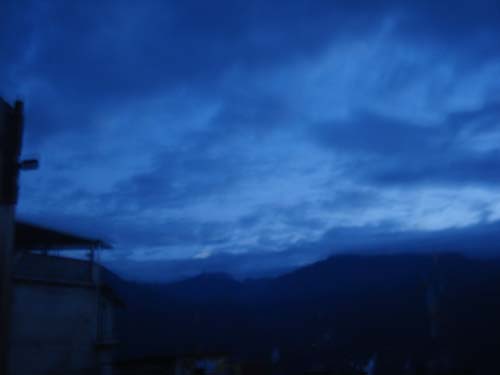
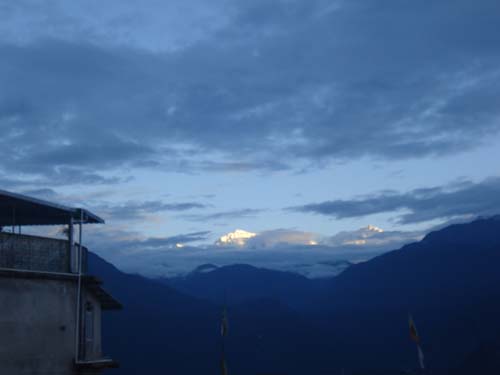
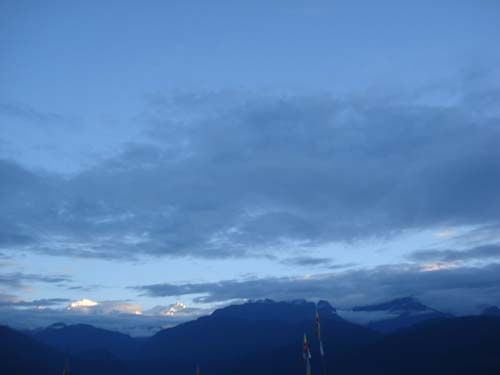
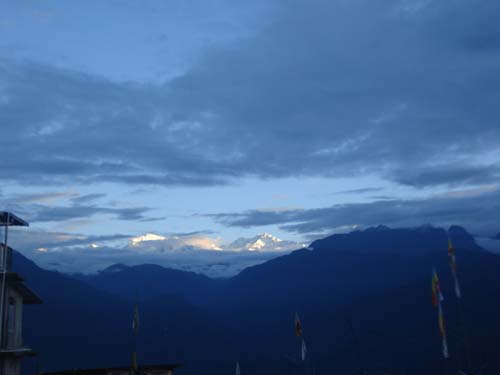
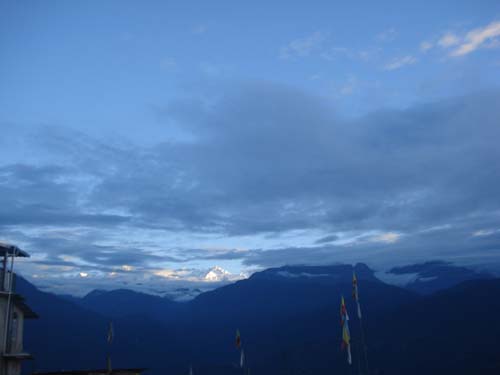
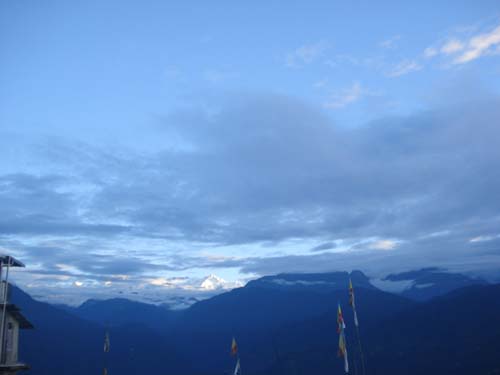
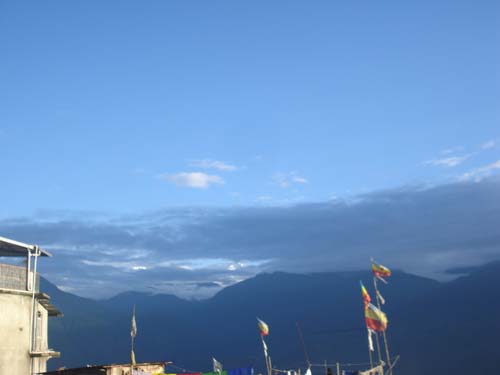
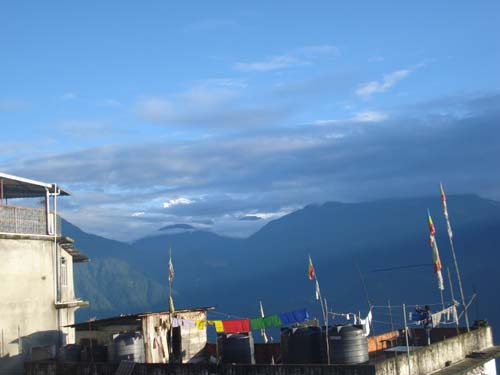
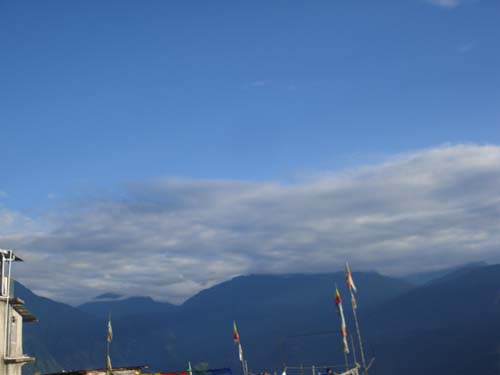
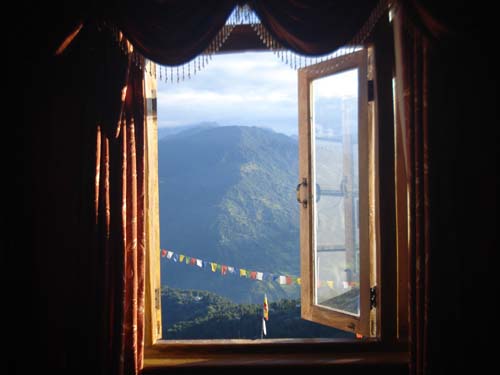
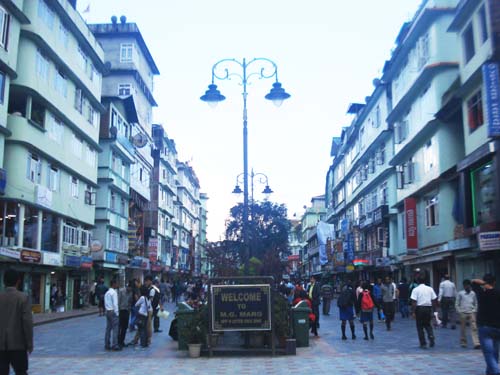
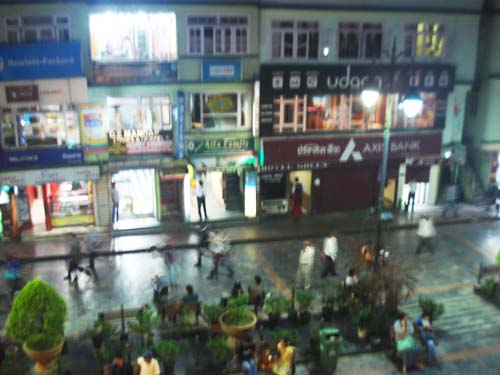
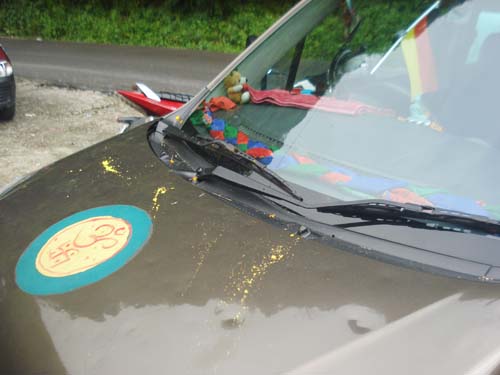
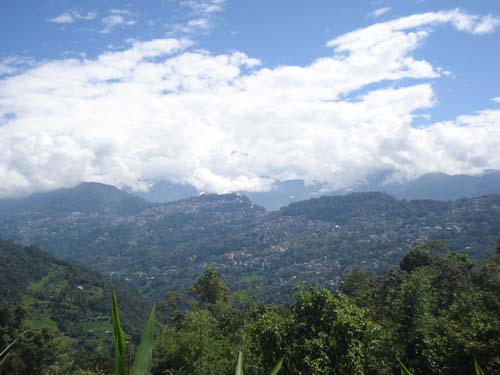
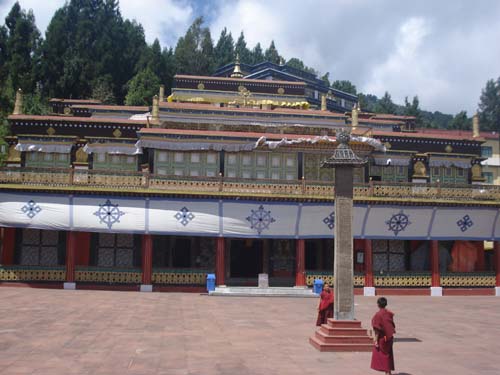
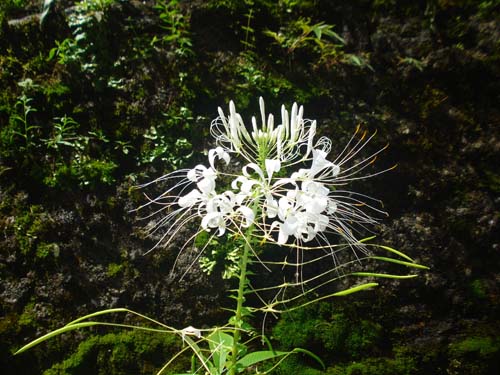
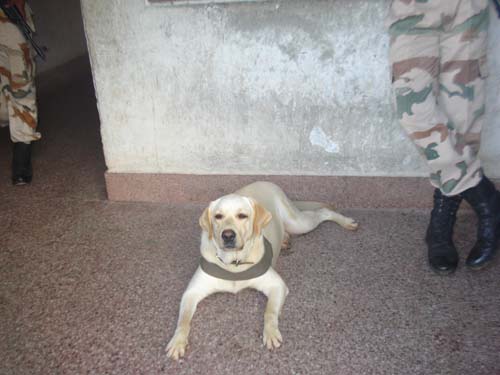
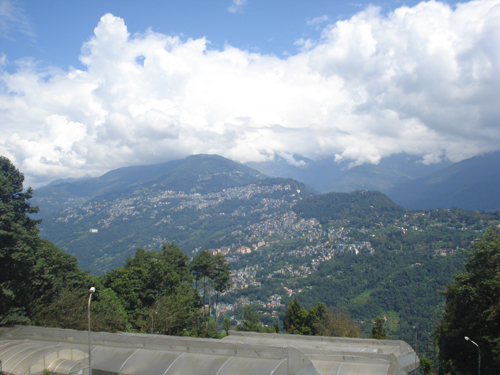
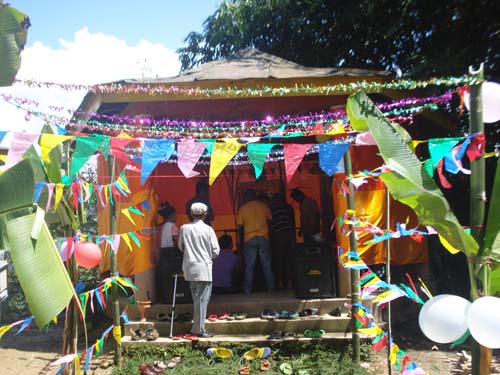
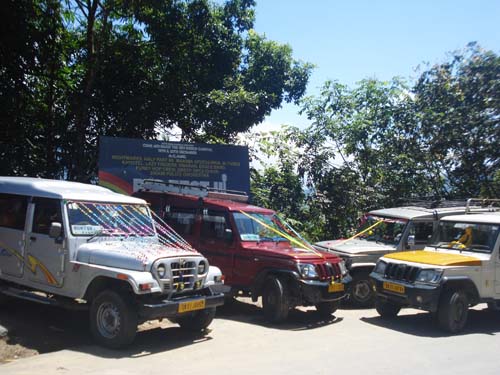
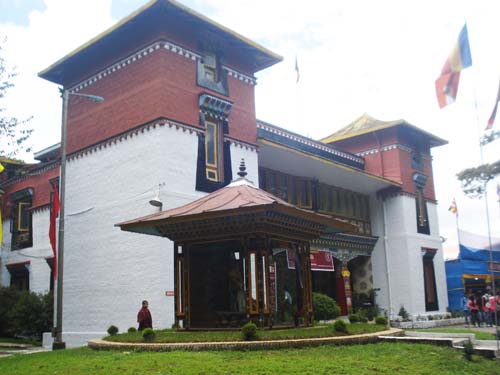
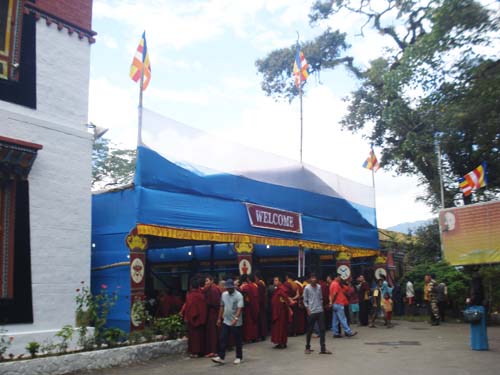
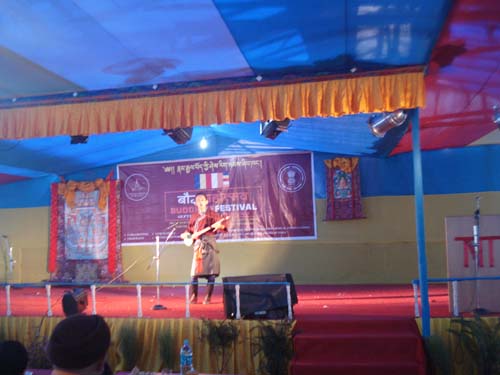
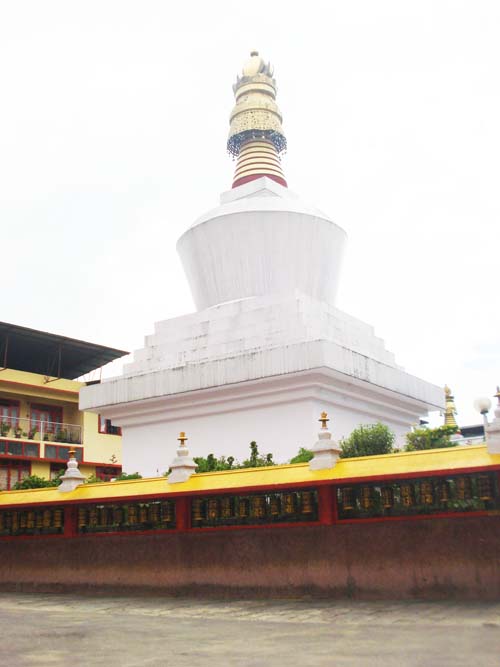
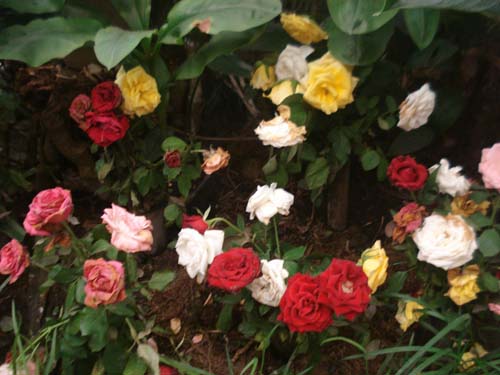
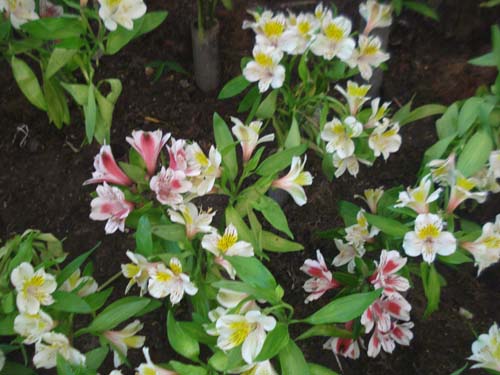
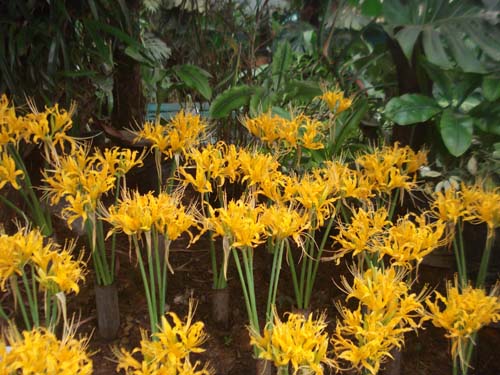
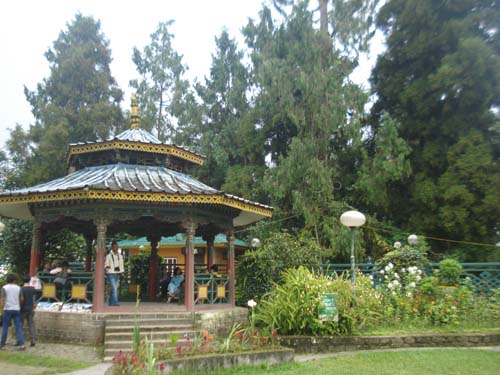
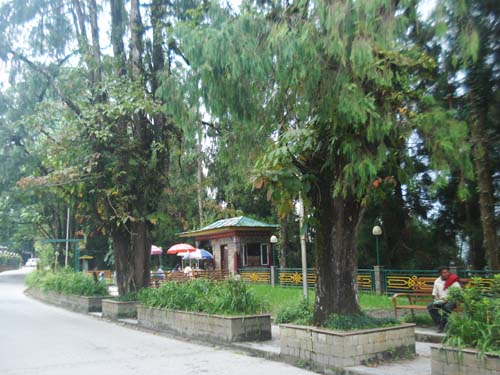
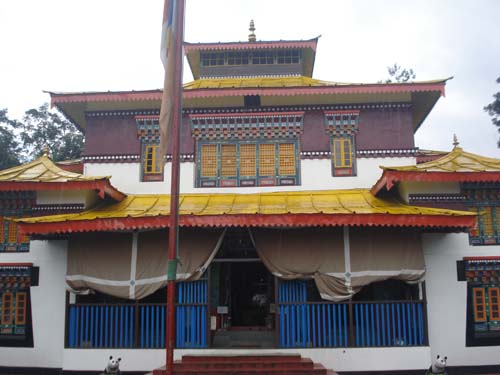
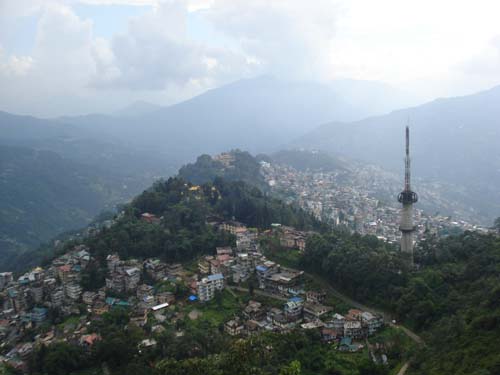
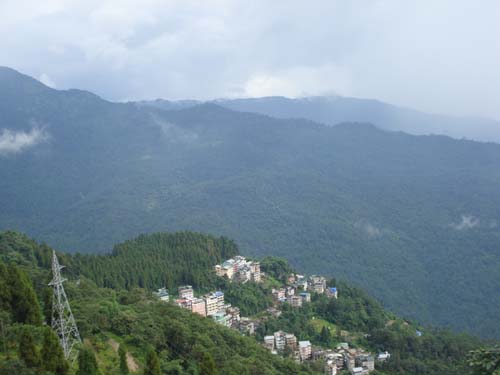
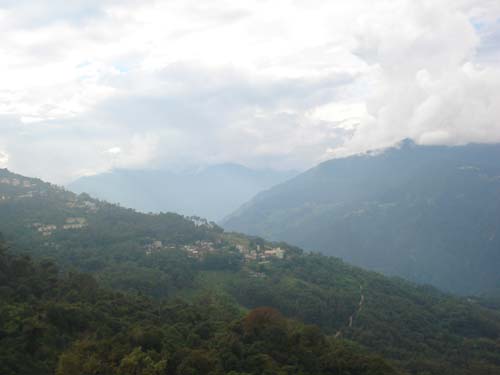
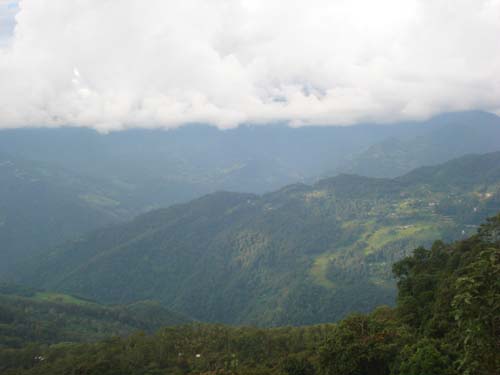
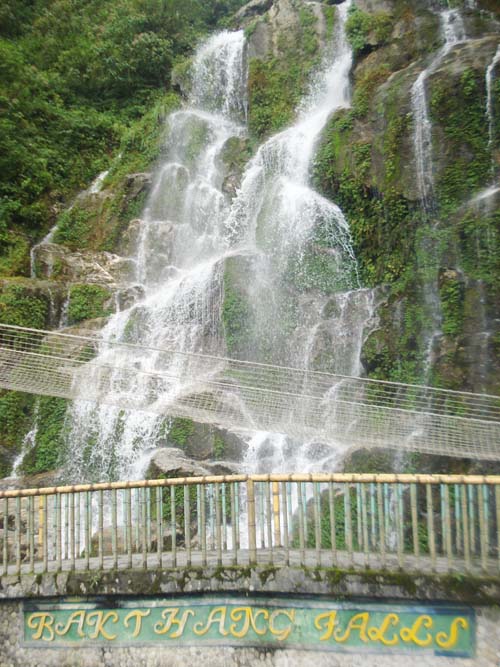
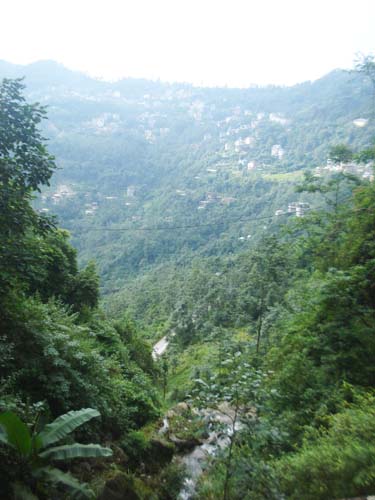
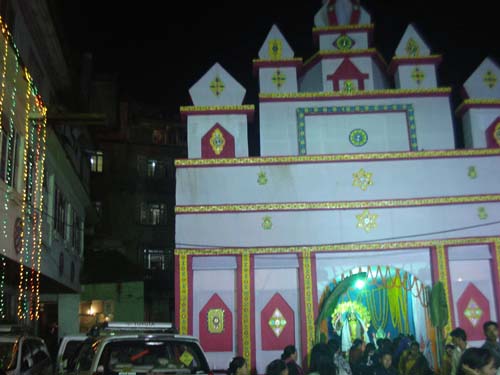
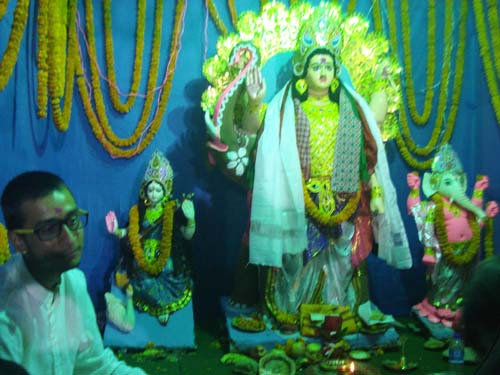
Its I think, 10th+ time I been at took local trip of Gangtok, but d difference’s just now I’d travelled again through your eyes & your nice elaborate detailing.. thnx
LikeLiked by 1 person
Thanks so much, Prasad 🙂 Best
LikeLike
Hey swarupa ,I had to scroll back to see your name though, wonderful travelogue I must say, I almost walked through the lanes you did ,such is your narrative.Am sure it’s going to be an immense help as I have already planned a 6day trip to Gangtok and Darjeeling with family. Thank you so very much
LikeLiked by 1 person
Hi Anil, Thanks so much 🙂 Happy travels. Best 🙂
LikeLike